In-Depth Analysis: Zara Online's Applied Corporate Strategy Model
VerifiedAdded on 2023/04/06
|24
|4558
|482
Report
AI Summary
This report provides a comprehensive strategic analysis of Zara Online, a Spanish clothing and accessories brand and a major part of the Inditex Group. It begins with an external analysis using the PESTEL framework, examining political, economic, social, technological, environmental, and legal factors impacting Zara's global operations. Following this, Porter's Five Forces model is applied to assess the competitive landscape, highlighting the low threat of new entrants and substitutes, weak bargaining power of suppliers and buyers, and strong rivalry among existing firms. The report then delves into Zara's resources and key competencies, evaluating resources threshold, value chain activities, and VRIO analysis to identify core competencies that provide a competitive advantage, such as a dynamic supply chain and strong brand presence. The online strategy is evaluated using SWOT and TOWS analysis, pinpointing strengths like cost leadership and efficient supply chain, weaknesses including high training costs and limited marketing, opportunities for global market expansion, and threats from high-end competitors and economic downturns. The report concludes that the fashion industry is not attractive due to high barriers and costs, emphasizing the importance of economies of scale for survival.
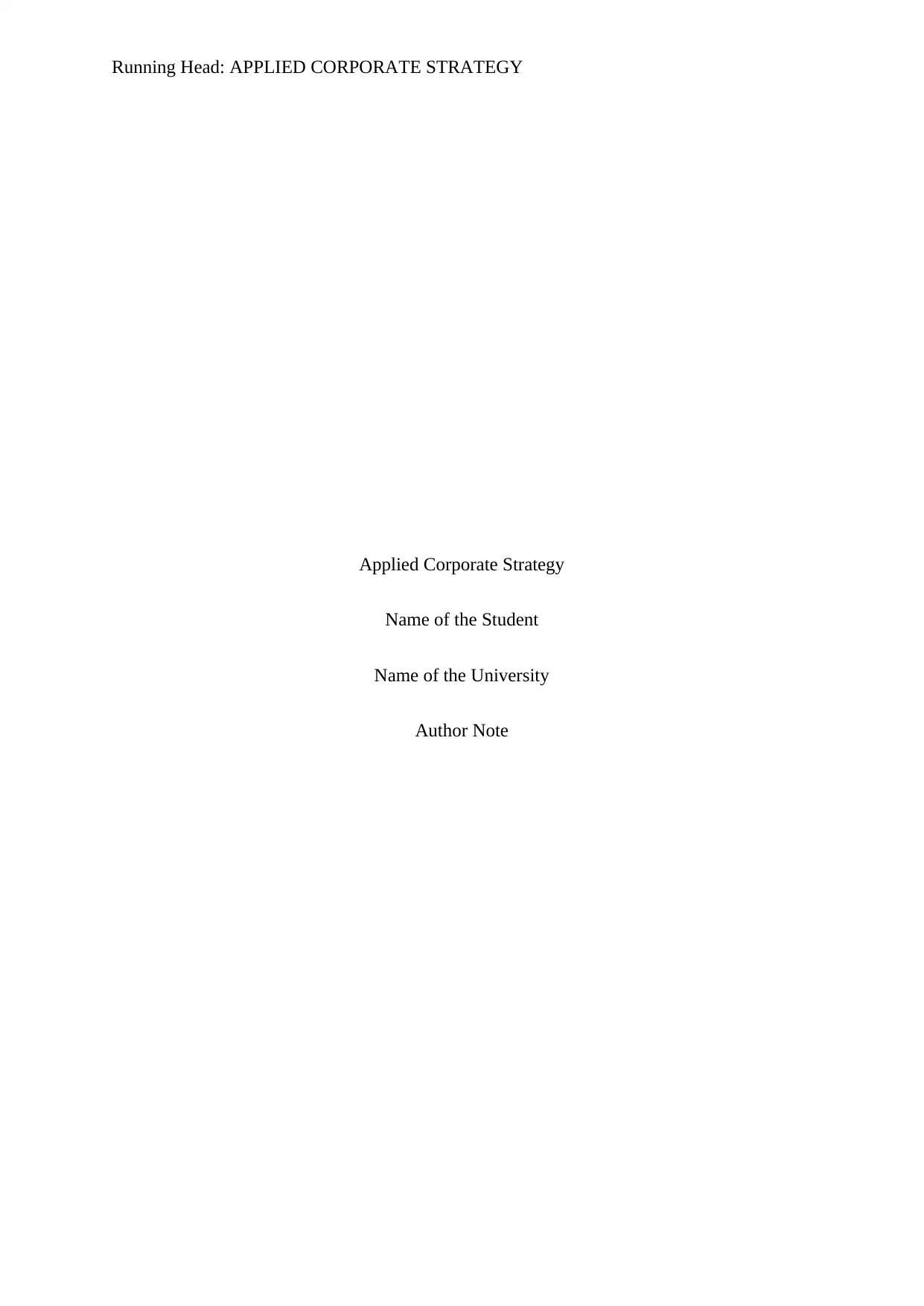
Running Head: APPLIED CORPORATE STRATEGY
Applied Corporate Strategy
Name of the Student
Name of the University
Author Note
Applied Corporate Strategy
Name of the Student
Name of the University
Author Note
Paraphrase This Document
Need a fresh take? Get an instant paraphrase of this document with our AI Paraphraser
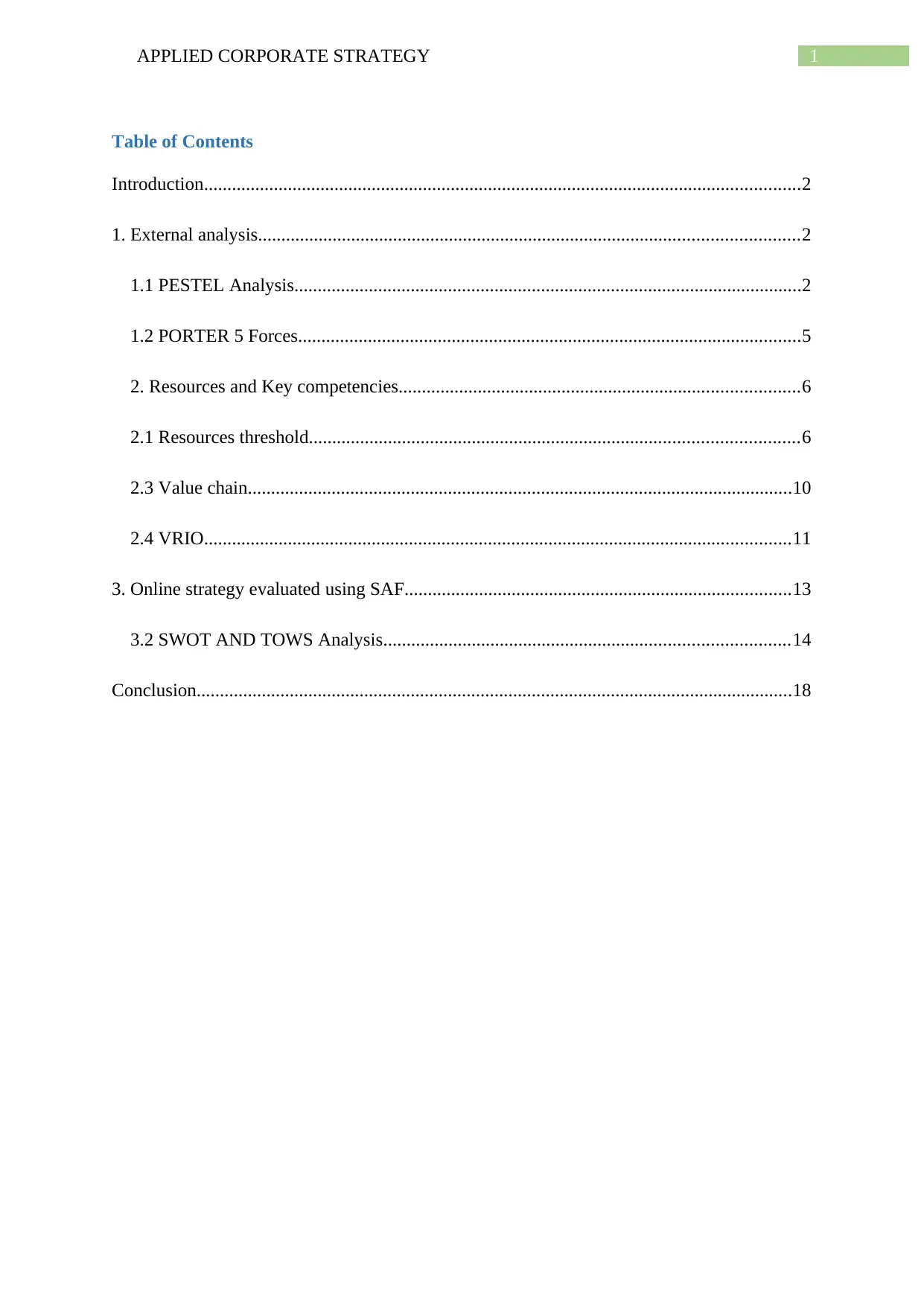
1APPLIED CORPORATE STRATEGY
Table of Contents
Introduction................................................................................................................................2
1. External analysis....................................................................................................................2
1.1 PESTEL Analysis.............................................................................................................2
1.2 PORTER 5 Forces............................................................................................................5
2. Resources and Key competencies......................................................................................6
2.1 Resources threshold.........................................................................................................6
2.3 Value chain.....................................................................................................................10
2.4 VRIO..............................................................................................................................11
3. Online strategy evaluated using SAF...................................................................................13
3.2 SWOT AND TOWS Analysis.......................................................................................14
Conclusion................................................................................................................................18
Table of Contents
Introduction................................................................................................................................2
1. External analysis....................................................................................................................2
1.1 PESTEL Analysis.............................................................................................................2
1.2 PORTER 5 Forces............................................................................................................5
2. Resources and Key competencies......................................................................................6
2.1 Resources threshold.........................................................................................................6
2.3 Value chain.....................................................................................................................10
2.4 VRIO..............................................................................................................................11
3. Online strategy evaluated using SAF...................................................................................13
3.2 SWOT AND TOWS Analysis.......................................................................................14
Conclusion................................................................................................................................18
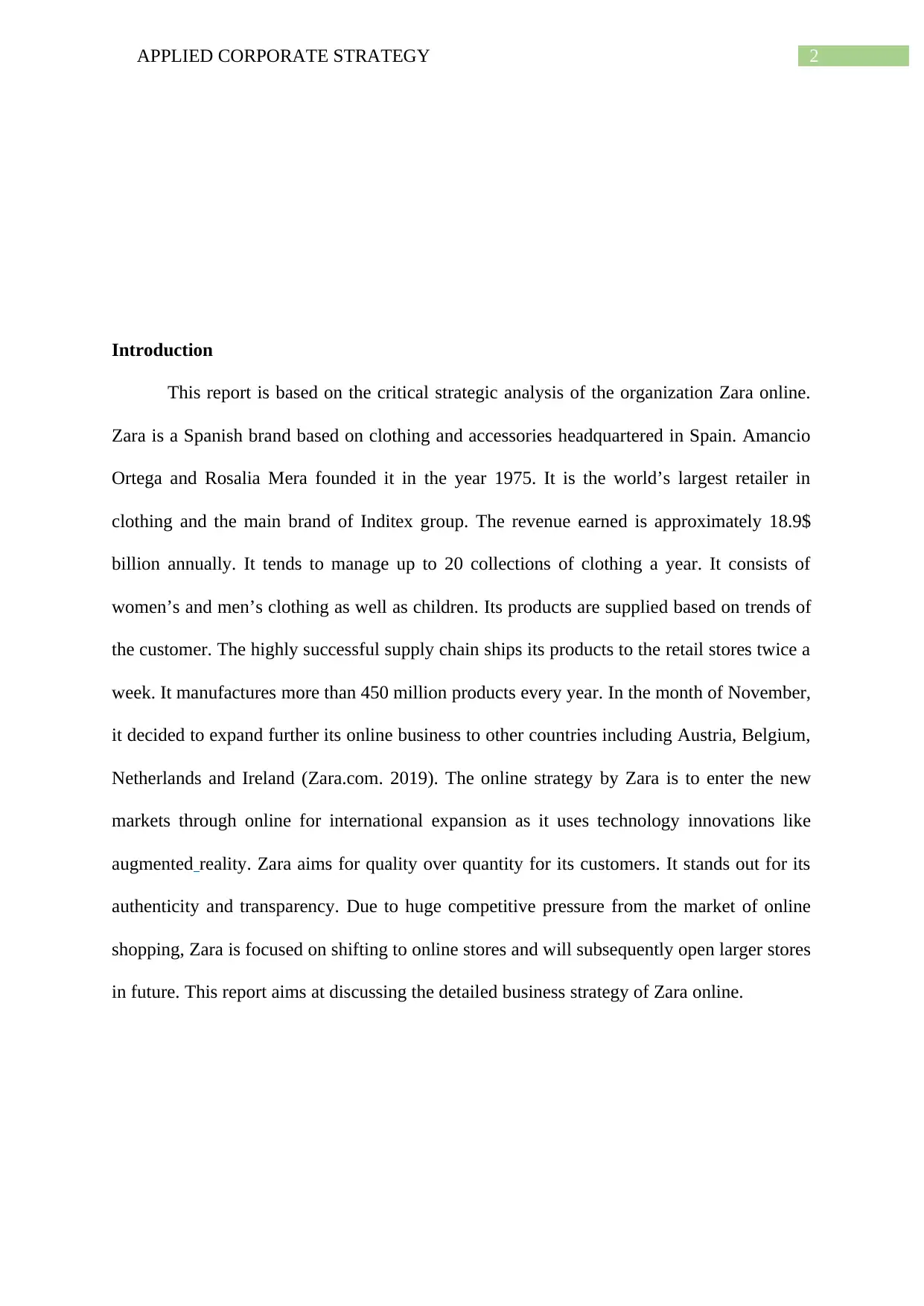
2APPLIED CORPORATE STRATEGY
Introduction
This report is based on the critical strategic analysis of the organization Zara online.
Zara is a Spanish brand based on clothing and accessories headquartered in Spain. Amancio
Ortega and Rosalia Mera founded it in the year 1975. It is the world’s largest retailer in
clothing and the main brand of Inditex group. The revenue earned is approximately 18.9$
billion annually. It tends to manage up to 20 collections of clothing a year. It consists of
women’s and men’s clothing as well as children. Its products are supplied based on trends of
the customer. The highly successful supply chain ships its products to the retail stores twice a
week. It manufactures more than 450 million products every year. In the month of November,
it decided to expand further its online business to other countries including Austria, Belgium,
Netherlands and Ireland (Zara.com. 2019). The online strategy by Zara is to enter the new
markets through online for international expansion as it uses technology innovations like
augmented reality. Zara aims for quality over quantity for its customers. It stands out for its
authenticity and transparency. Due to huge competitive pressure from the market of online
shopping, Zara is focused on shifting to online stores and will subsequently open larger stores
in future. This report aims at discussing the detailed business strategy of Zara online.
Introduction
This report is based on the critical strategic analysis of the organization Zara online.
Zara is a Spanish brand based on clothing and accessories headquartered in Spain. Amancio
Ortega and Rosalia Mera founded it in the year 1975. It is the world’s largest retailer in
clothing and the main brand of Inditex group. The revenue earned is approximately 18.9$
billion annually. It tends to manage up to 20 collections of clothing a year. It consists of
women’s and men’s clothing as well as children. Its products are supplied based on trends of
the customer. The highly successful supply chain ships its products to the retail stores twice a
week. It manufactures more than 450 million products every year. In the month of November,
it decided to expand further its online business to other countries including Austria, Belgium,
Netherlands and Ireland (Zara.com. 2019). The online strategy by Zara is to enter the new
markets through online for international expansion as it uses technology innovations like
augmented reality. Zara aims for quality over quantity for its customers. It stands out for its
authenticity and transparency. Due to huge competitive pressure from the market of online
shopping, Zara is focused on shifting to online stores and will subsequently open larger stores
in future. This report aims at discussing the detailed business strategy of Zara online.
⊘ This is a preview!⊘
Do you want full access?
Subscribe today to unlock all pages.

Trusted by 1+ million students worldwide
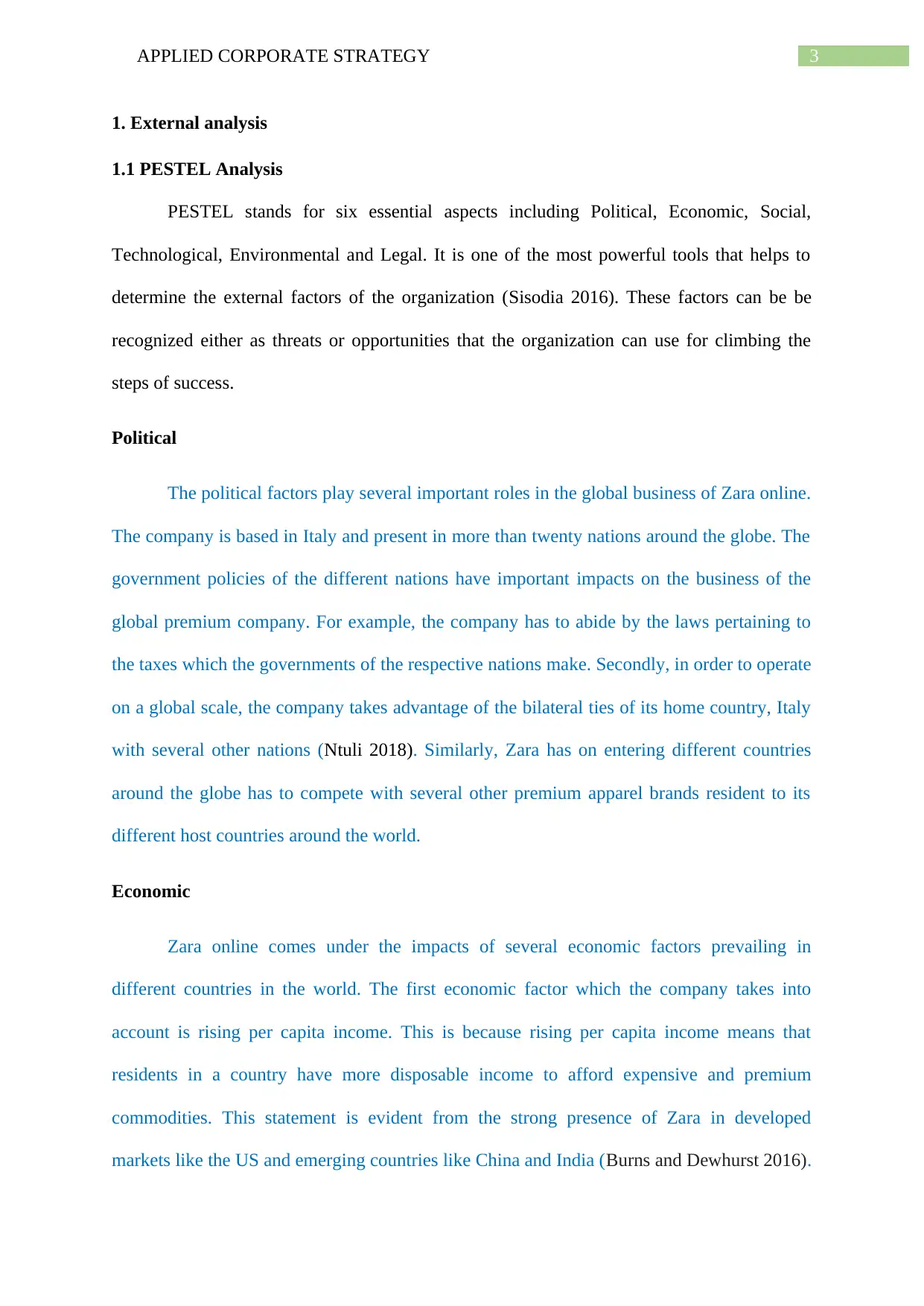
3APPLIED CORPORATE STRATEGY
1. External analysis
1.1 PESTEL Analysis
PESTEL stands for six essential aspects including Political, Economic, Social,
Technological, Environmental and Legal. It is one of the most powerful tools that helps to
determine the external factors of the organization (Sisodia 2016). These factors can be be
recognized either as threats or opportunities that the organization can use for climbing the
steps of success.
Political
The political factors play several important roles in the global business of Zara online.
The company is based in Italy and present in more than twenty nations around the globe. The
government policies of the different nations have important impacts on the business of the
global premium company. For example, the company has to abide by the laws pertaining to
the taxes which the governments of the respective nations make. Secondly, in order to operate
on a global scale, the company takes advantage of the bilateral ties of its home country, Italy
with several other nations (Ntuli 2018). Similarly, Zara has on entering different countries
around the globe has to compete with several other premium apparel brands resident to its
different host countries around the world.
Economic
Zara online comes under the impacts of several economic factors prevailing in
different countries in the world. The first economic factor which the company takes into
account is rising per capita income. This is because rising per capita income means that
residents in a country have more disposable income to afford expensive and premium
commodities. This statement is evident from the strong presence of Zara in developed
markets like the US and emerging countries like China and India (Burns and Dewhurst 2016).
1. External analysis
1.1 PESTEL Analysis
PESTEL stands for six essential aspects including Political, Economic, Social,
Technological, Environmental and Legal. It is one of the most powerful tools that helps to
determine the external factors of the organization (Sisodia 2016). These factors can be be
recognized either as threats or opportunities that the organization can use for climbing the
steps of success.
Political
The political factors play several important roles in the global business of Zara online.
The company is based in Italy and present in more than twenty nations around the globe. The
government policies of the different nations have important impacts on the business of the
global premium company. For example, the company has to abide by the laws pertaining to
the taxes which the governments of the respective nations make. Secondly, in order to operate
on a global scale, the company takes advantage of the bilateral ties of its home country, Italy
with several other nations (Ntuli 2018). Similarly, Zara has on entering different countries
around the globe has to compete with several other premium apparel brands resident to its
different host countries around the world.
Economic
Zara online comes under the impacts of several economic factors prevailing in
different countries in the world. The first economic factor which the company takes into
account is rising per capita income. This is because rising per capita income means that
residents in a country have more disposable income to afford expensive and premium
commodities. This statement is evident from the strong presence of Zara in developed
markets like the US and emerging countries like China and India (Burns and Dewhurst 2016).
Paraphrase This Document
Need a fresh take? Get an instant paraphrase of this document with our AI Paraphraser
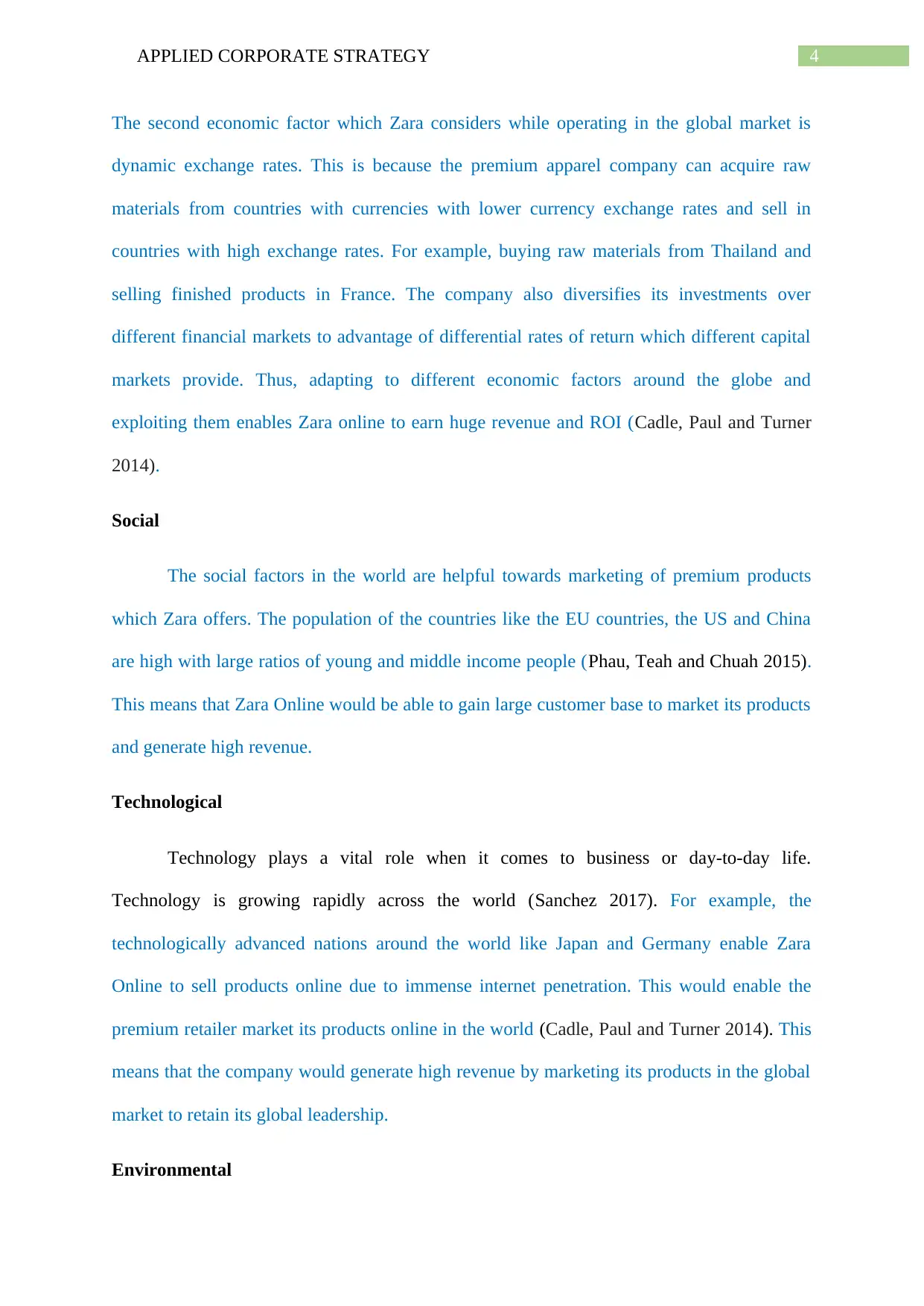
4APPLIED CORPORATE STRATEGY
The second economic factor which Zara considers while operating in the global market is
dynamic exchange rates. This is because the premium apparel company can acquire raw
materials from countries with currencies with lower currency exchange rates and sell in
countries with high exchange rates. For example, buying raw materials from Thailand and
selling finished products in France. The company also diversifies its investments over
different financial markets to advantage of differential rates of return which different capital
markets provide. Thus, adapting to different economic factors around the globe and
exploiting them enables Zara online to earn huge revenue and ROI (Cadle, Paul and Turner
2014).
Social
The social factors in the world are helpful towards marketing of premium products
which Zara offers. The population of the countries like the EU countries, the US and China
are high with large ratios of young and middle income people (Phau, Teah and Chuah 2015).
This means that Zara Online would be able to gain large customer base to market its products
and generate high revenue.
Technological
Technology plays a vital role when it comes to business or day-to-day life.
Technology is growing rapidly across the world (Sanchez 2017). For example, the
technologically advanced nations around the world like Japan and Germany enable Zara
Online to sell products online due to immense internet penetration. This would enable the
premium retailer market its products online in the world (Cadle, Paul and Turner 2014). This
means that the company would generate high revenue by marketing its products in the global
market to retain its global leadership.
Environmental
The second economic factor which Zara considers while operating in the global market is
dynamic exchange rates. This is because the premium apparel company can acquire raw
materials from countries with currencies with lower currency exchange rates and sell in
countries with high exchange rates. For example, buying raw materials from Thailand and
selling finished products in France. The company also diversifies its investments over
different financial markets to advantage of differential rates of return which different capital
markets provide. Thus, adapting to different economic factors around the globe and
exploiting them enables Zara online to earn huge revenue and ROI (Cadle, Paul and Turner
2014).
Social
The social factors in the world are helpful towards marketing of premium products
which Zara offers. The population of the countries like the EU countries, the US and China
are high with large ratios of young and middle income people (Phau, Teah and Chuah 2015).
This means that Zara Online would be able to gain large customer base to market its products
and generate high revenue.
Technological
Technology plays a vital role when it comes to business or day-to-day life.
Technology is growing rapidly across the world (Sanchez 2017). For example, the
technologically advanced nations around the world like Japan and Germany enable Zara
Online to sell products online due to immense internet penetration. This would enable the
premium retailer market its products online in the world (Cadle, Paul and Turner 2014). This
means that the company would generate high revenue by marketing its products in the global
market to retain its global leadership.
Environmental
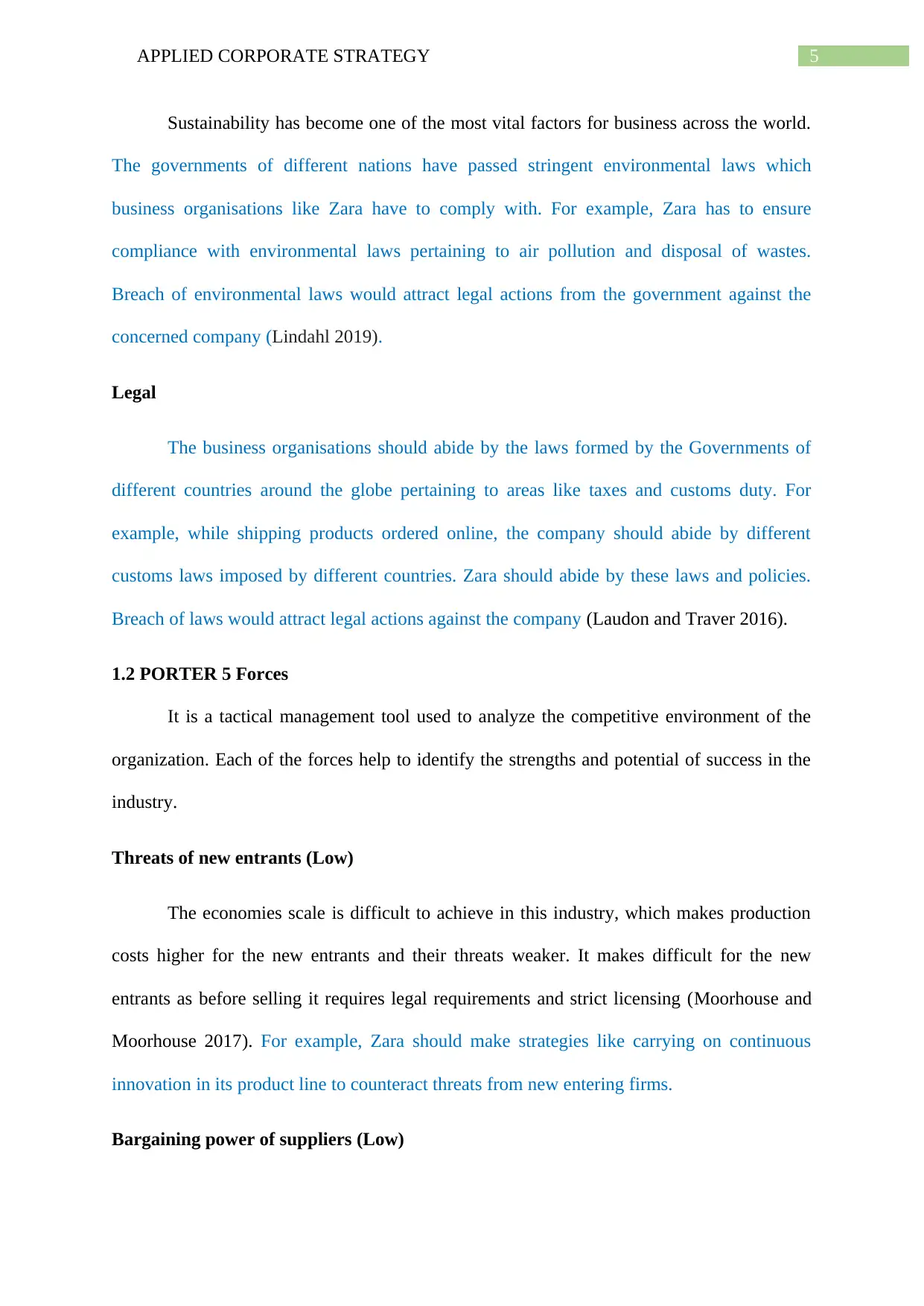
5APPLIED CORPORATE STRATEGY
Sustainability has become one of the most vital factors for business across the world.
The governments of different nations have passed stringent environmental laws which
business organisations like Zara have to comply with. For example, Zara has to ensure
compliance with environmental laws pertaining to air pollution and disposal of wastes.
Breach of environmental laws would attract legal actions from the government against the
concerned company (Lindahl 2019).
Legal
The business organisations should abide by the laws formed by the Governments of
different countries around the globe pertaining to areas like taxes and customs duty. For
example, while shipping products ordered online, the company should abide by different
customs laws imposed by different countries. Zara should abide by these laws and policies.
Breach of laws would attract legal actions against the company (Laudon and Traver 2016).
1.2 PORTER 5 Forces
It is a tactical management tool used to analyze the competitive environment of the
organization. Each of the forces help to identify the strengths and potential of success in the
industry.
Threats of new entrants (Low)
The economies scale is difficult to achieve in this industry, which makes production
costs higher for the new entrants and their threats weaker. It makes difficult for the new
entrants as before selling it requires legal requirements and strict licensing (Moorhouse and
Moorhouse 2017). For example, Zara should make strategies like carrying on continuous
innovation in its product line to counteract threats from new entering firms.
Bargaining power of suppliers (Low)
Sustainability has become one of the most vital factors for business across the world.
The governments of different nations have passed stringent environmental laws which
business organisations like Zara have to comply with. For example, Zara has to ensure
compliance with environmental laws pertaining to air pollution and disposal of wastes.
Breach of environmental laws would attract legal actions from the government against the
concerned company (Lindahl 2019).
Legal
The business organisations should abide by the laws formed by the Governments of
different countries around the globe pertaining to areas like taxes and customs duty. For
example, while shipping products ordered online, the company should abide by different
customs laws imposed by different countries. Zara should abide by these laws and policies.
Breach of laws would attract legal actions against the company (Laudon and Traver 2016).
1.2 PORTER 5 Forces
It is a tactical management tool used to analyze the competitive environment of the
organization. Each of the forces help to identify the strengths and potential of success in the
industry.
Threats of new entrants (Low)
The economies scale is difficult to achieve in this industry, which makes production
costs higher for the new entrants and their threats weaker. It makes difficult for the new
entrants as before selling it requires legal requirements and strict licensing (Moorhouse and
Moorhouse 2017). For example, Zara should make strategies like carrying on continuous
innovation in its product line to counteract threats from new entering firms.
Bargaining power of suppliers (Low)
⊘ This is a preview!⊘
Do you want full access?
Subscribe today to unlock all pages.

Trusted by 1+ million students worldwide

6APPLIED CORPORATE STRATEGY
Zara has back word vertical integration, and power over its suppliers, dictating the
price, quality and quantity, fact which give the suppliers less control, making the bargaining
power of suppliers weak (Burns and Dewhurst, 2016).
Bargaining power of buyers (Low-Medium)
Zara offers products based on customer needs and feedback. Affordable prices of its
products makes the buyers make frequent purchases even though the customer has the choice
in the buying decision, with no switching costs they have to pay the price making bargaining
power low to medium (Adi, 2015).
Threat of substitute products (Low)
The substitutes for Zara`s products are provided by the non-profit industries or
groceries stores, despite the fact that these substitutes are not fashionable, the threats of
substitute products is weak (Anton 2015).
Rivalry from existing firms (Strong)
The nature of the rivalry in this industry is tight, fearless and high. Zara has earned a
strong position within the fast fashion market and most of its competitors are trying to copy
its business model. Due to high investment in capital, the way out barriers is also high
because of government policies and restrictions. These make the companies hesitant to leave
the business and continue at producing low profits (Burns and Dewhurst 2016). By carrying
out the business environment and industry analysis, it can be concluded that the fashion
industry is not attractive. Barriers and costs are too high, and without economy of scale will
be hard to survive within this environment.
Zara has back word vertical integration, and power over its suppliers, dictating the
price, quality and quantity, fact which give the suppliers less control, making the bargaining
power of suppliers weak (Burns and Dewhurst, 2016).
Bargaining power of buyers (Low-Medium)
Zara offers products based on customer needs and feedback. Affordable prices of its
products makes the buyers make frequent purchases even though the customer has the choice
in the buying decision, with no switching costs they have to pay the price making bargaining
power low to medium (Adi, 2015).
Threat of substitute products (Low)
The substitutes for Zara`s products are provided by the non-profit industries or
groceries stores, despite the fact that these substitutes are not fashionable, the threats of
substitute products is weak (Anton 2015).
Rivalry from existing firms (Strong)
The nature of the rivalry in this industry is tight, fearless and high. Zara has earned a
strong position within the fast fashion market and most of its competitors are trying to copy
its business model. Due to high investment in capital, the way out barriers is also high
because of government policies and restrictions. These make the companies hesitant to leave
the business and continue at producing low profits (Burns and Dewhurst 2016). By carrying
out the business environment and industry analysis, it can be concluded that the fashion
industry is not attractive. Barriers and costs are too high, and without economy of scale will
be hard to survive within this environment.
Paraphrase This Document
Need a fresh take? Get an instant paraphrase of this document with our AI Paraphraser
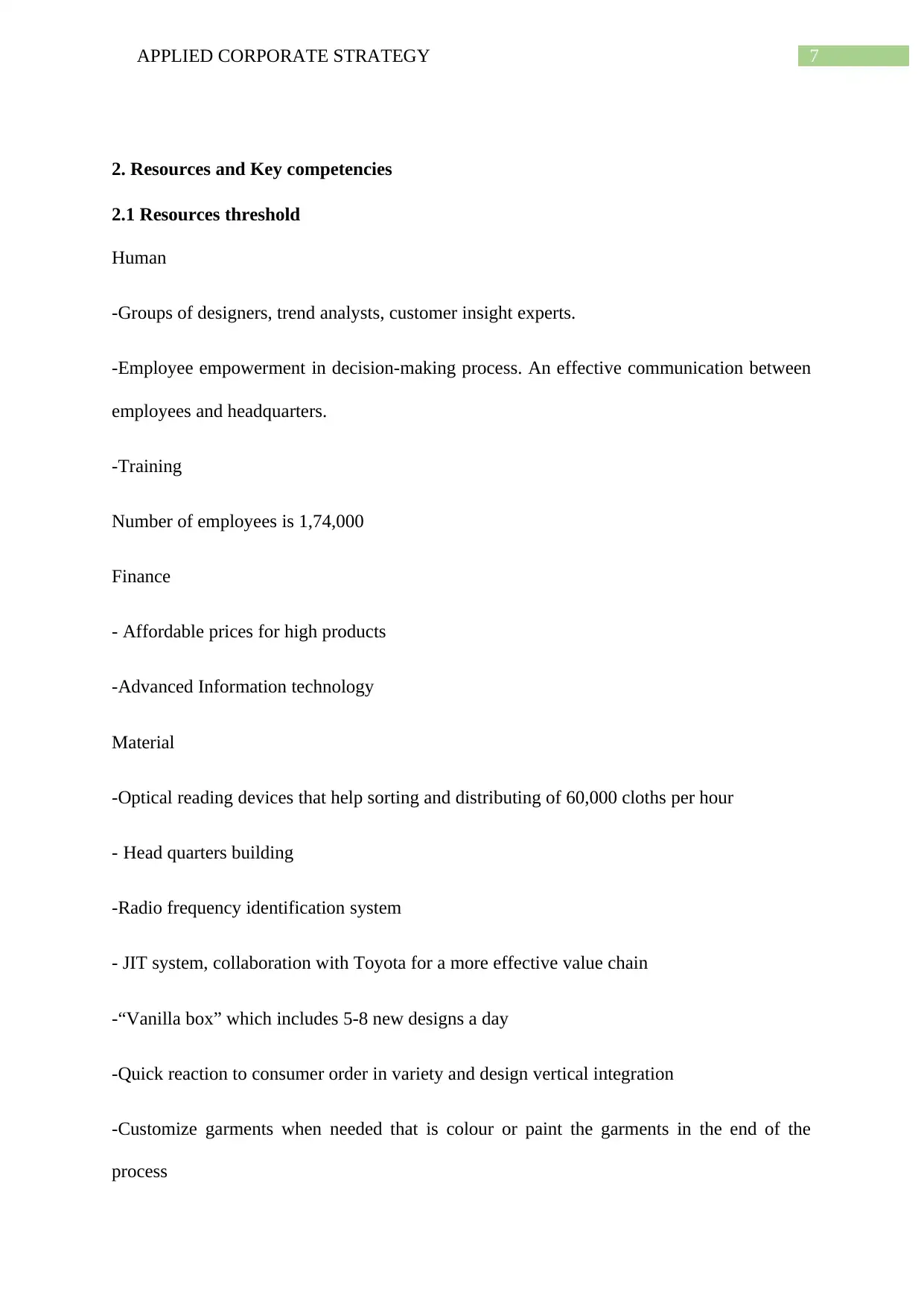
7APPLIED CORPORATE STRATEGY
2. Resources and Key competencies
2.1 Resources threshold
Human
-Groups of designers, trend analysts, customer insight experts.
-Employee empowerment in decision-making process. An effective communication between
employees and headquarters.
-Training
Number of employees is 1,74,000
Finance
- Affordable prices for high products
-Advanced Information technology
Material
-Optical reading devices that help sorting and distributing of 60,000 cloths per hour
- Head quarters building
-Radio frequency identification system
- JIT system, collaboration with Toyota for a more effective value chain
-“Vanilla box” which includes 5-8 new designs a day
-Quick reaction to consumer order in variety and design vertical integration
-Customize garments when needed that is colour or paint the garments in the end of the
process
2. Resources and Key competencies
2.1 Resources threshold
Human
-Groups of designers, trend analysts, customer insight experts.
-Employee empowerment in decision-making process. An effective communication between
employees and headquarters.
-Training
Number of employees is 1,74,000
Finance
- Affordable prices for high products
-Advanced Information technology
Material
-Optical reading devices that help sorting and distributing of 60,000 cloths per hour
- Head quarters building
-Radio frequency identification system
- JIT system, collaboration with Toyota for a more effective value chain
-“Vanilla box” which includes 5-8 new designs a day
-Quick reaction to consumer order in variety and design vertical integration
-Customize garments when needed that is colour or paint the garments in the end of the
process
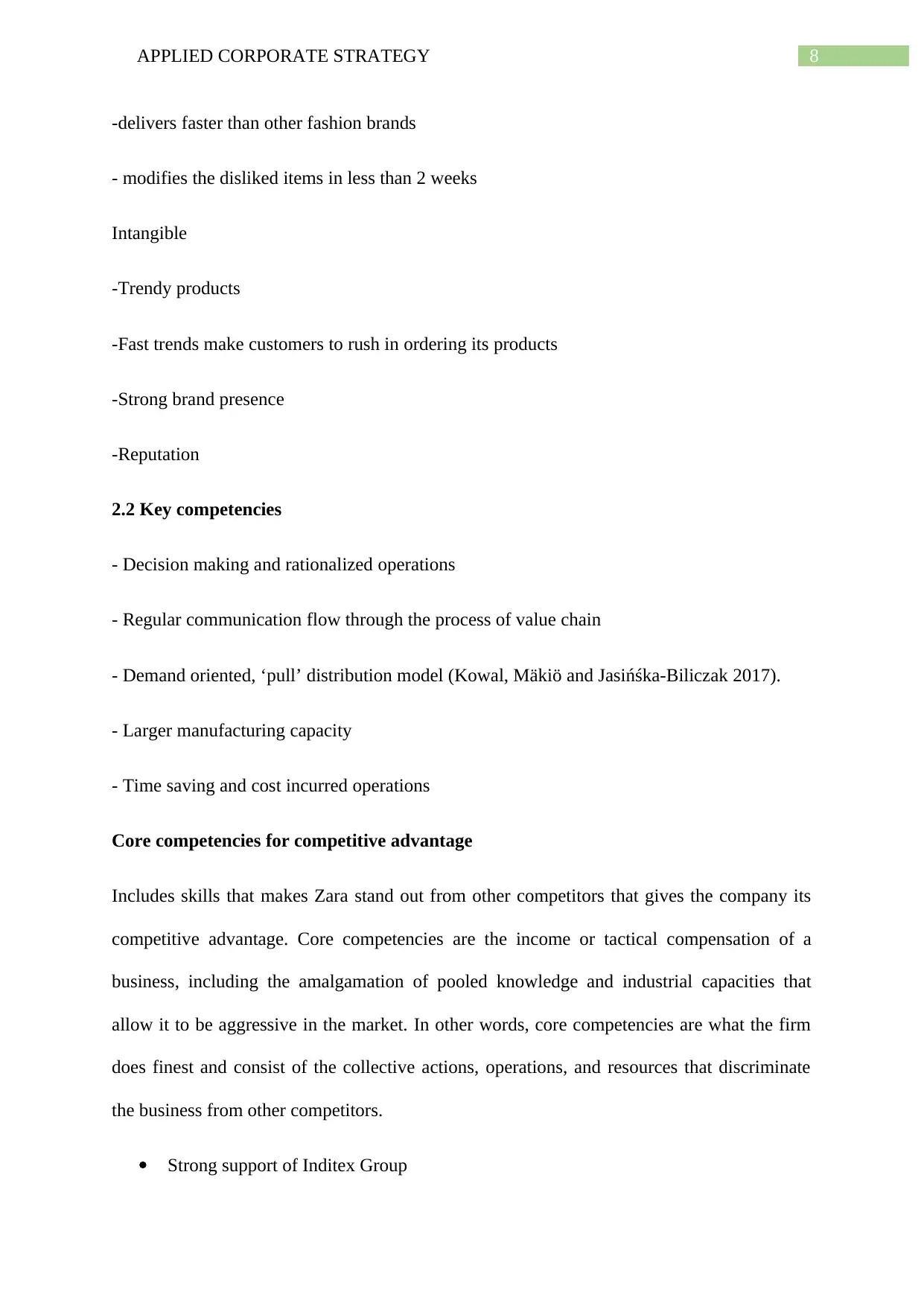
8APPLIED CORPORATE STRATEGY
-delivers faster than other fashion brands
- modifies the disliked items in less than 2 weeks
Intangible
-Trendy products
-Fast trends make customers to rush in ordering its products
-Strong brand presence
-Reputation
2.2 Key competencies
- Decision making and rationalized operations
- Regular communication flow through the process of value chain
- Demand oriented, ‘pull’ distribution model (Kowal, Mäkiö and Jasińśka-Biliczak 2017).
- Larger manufacturing capacity
- Time saving and cost incurred operations
Core competencies for competitive advantage
Includes skills that makes Zara stand out from other competitors that gives the company its
competitive advantage. Core competencies are the income or tactical compensation of a
business, including the amalgamation of pooled knowledge and industrial capacities that
allow it to be aggressive in the market. In other words, core competencies are what the firm
does finest and consist of the collective actions, operations, and resources that discriminate
the business from other competitors.
Strong support of Inditex Group
-delivers faster than other fashion brands
- modifies the disliked items in less than 2 weeks
Intangible
-Trendy products
-Fast trends make customers to rush in ordering its products
-Strong brand presence
-Reputation
2.2 Key competencies
- Decision making and rationalized operations
- Regular communication flow through the process of value chain
- Demand oriented, ‘pull’ distribution model (Kowal, Mäkiö and Jasińśka-Biliczak 2017).
- Larger manufacturing capacity
- Time saving and cost incurred operations
Core competencies for competitive advantage
Includes skills that makes Zara stand out from other competitors that gives the company its
competitive advantage. Core competencies are the income or tactical compensation of a
business, including the amalgamation of pooled knowledge and industrial capacities that
allow it to be aggressive in the market. In other words, core competencies are what the firm
does finest and consist of the collective actions, operations, and resources that discriminate
the business from other competitors.
Strong support of Inditex Group
⊘ This is a preview!⊘
Do you want full access?
Subscribe today to unlock all pages.

Trusted by 1+ million students worldwide
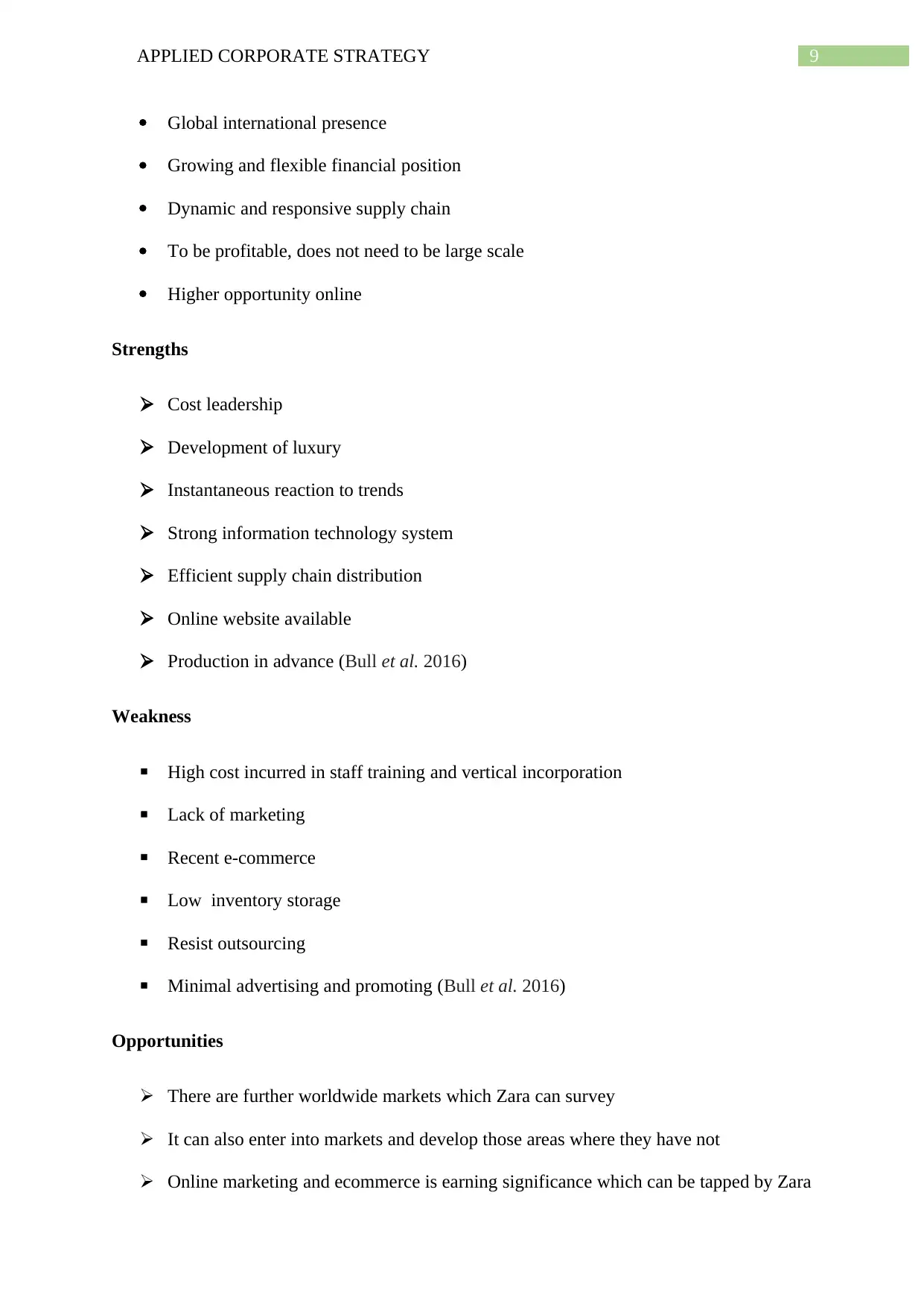
9APPLIED CORPORATE STRATEGY
Global international presence
Growing and flexible financial position
Dynamic and responsive supply chain
To be profitable, does not need to be large scale
Higher opportunity online
Strengths
Cost leadership
Development of luxury
Instantaneous reaction to trends
Strong information technology system
Efficient supply chain distribution
Online website available
Production in advance (Bull et al. 2016)
Weakness
High cost incurred in staff training and vertical incorporation
Lack of marketing
Recent e-commerce
Low inventory storage
Resist outsourcing
Minimal advertising and promoting (Bull et al. 2016)
Opportunities
There are further worldwide markets which Zara can survey
It can also enter into markets and develop those areas where they have not
Online marketing and ecommerce is earning significance which can be tapped by Zara
Global international presence
Growing and flexible financial position
Dynamic and responsive supply chain
To be profitable, does not need to be large scale
Higher opportunity online
Strengths
Cost leadership
Development of luxury
Instantaneous reaction to trends
Strong information technology system
Efficient supply chain distribution
Online website available
Production in advance (Bull et al. 2016)
Weakness
High cost incurred in staff training and vertical incorporation
Lack of marketing
Recent e-commerce
Low inventory storage
Resist outsourcing
Minimal advertising and promoting (Bull et al. 2016)
Opportunities
There are further worldwide markets which Zara can survey
It can also enter into markets and develop those areas where they have not
Online marketing and ecommerce is earning significance which can be tapped by Zara
Paraphrase This Document
Need a fresh take? Get an instant paraphrase of this document with our AI Paraphraser
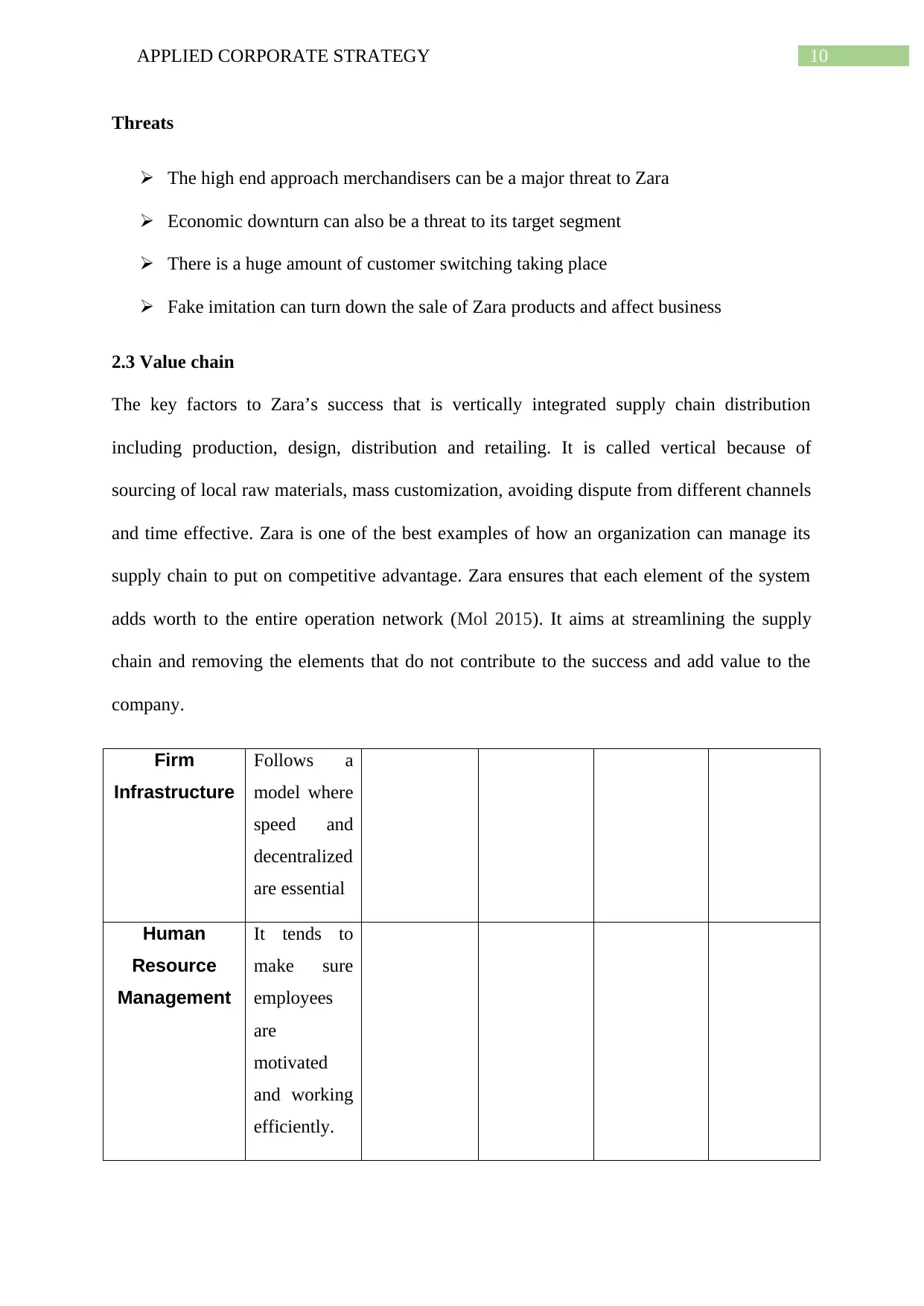
10APPLIED CORPORATE STRATEGY
Threats
The high end approach merchandisers can be a major threat to Zara
Economic downturn can also be a threat to its target segment
There is a huge amount of customer switching taking place
Fake imitation can turn down the sale of Zara products and affect business
2.3 Value chain
The key factors to Zara’s success that is vertically integrated supply chain distribution
including production, design, distribution and retailing. It is called vertical because of
sourcing of local raw materials, mass customization, avoiding dispute from different channels
and time effective. Zara is one of the best examples of how an organization can manage its
supply chain to put on competitive advantage. Zara ensures that each element of the system
adds worth to the entire operation network (Mol 2015). It aims at streamlining the supply
chain and removing the elements that do not contribute to the success and add value to the
company.
Firm
Infrastructure
Follows a
model where
speed and
decentralized
are essential
Human
Resource
Management
It tends to
make sure
employees
are
motivated
and working
efficiently.
Threats
The high end approach merchandisers can be a major threat to Zara
Economic downturn can also be a threat to its target segment
There is a huge amount of customer switching taking place
Fake imitation can turn down the sale of Zara products and affect business
2.3 Value chain
The key factors to Zara’s success that is vertically integrated supply chain distribution
including production, design, distribution and retailing. It is called vertical because of
sourcing of local raw materials, mass customization, avoiding dispute from different channels
and time effective. Zara is one of the best examples of how an organization can manage its
supply chain to put on competitive advantage. Zara ensures that each element of the system
adds worth to the entire operation network (Mol 2015). It aims at streamlining the supply
chain and removing the elements that do not contribute to the success and add value to the
company.
Firm
Infrastructure
Follows a
model where
speed and
decentralized
are essential
Human
Resource
Management
It tends to
make sure
employees
are
motivated
and working
efficiently.
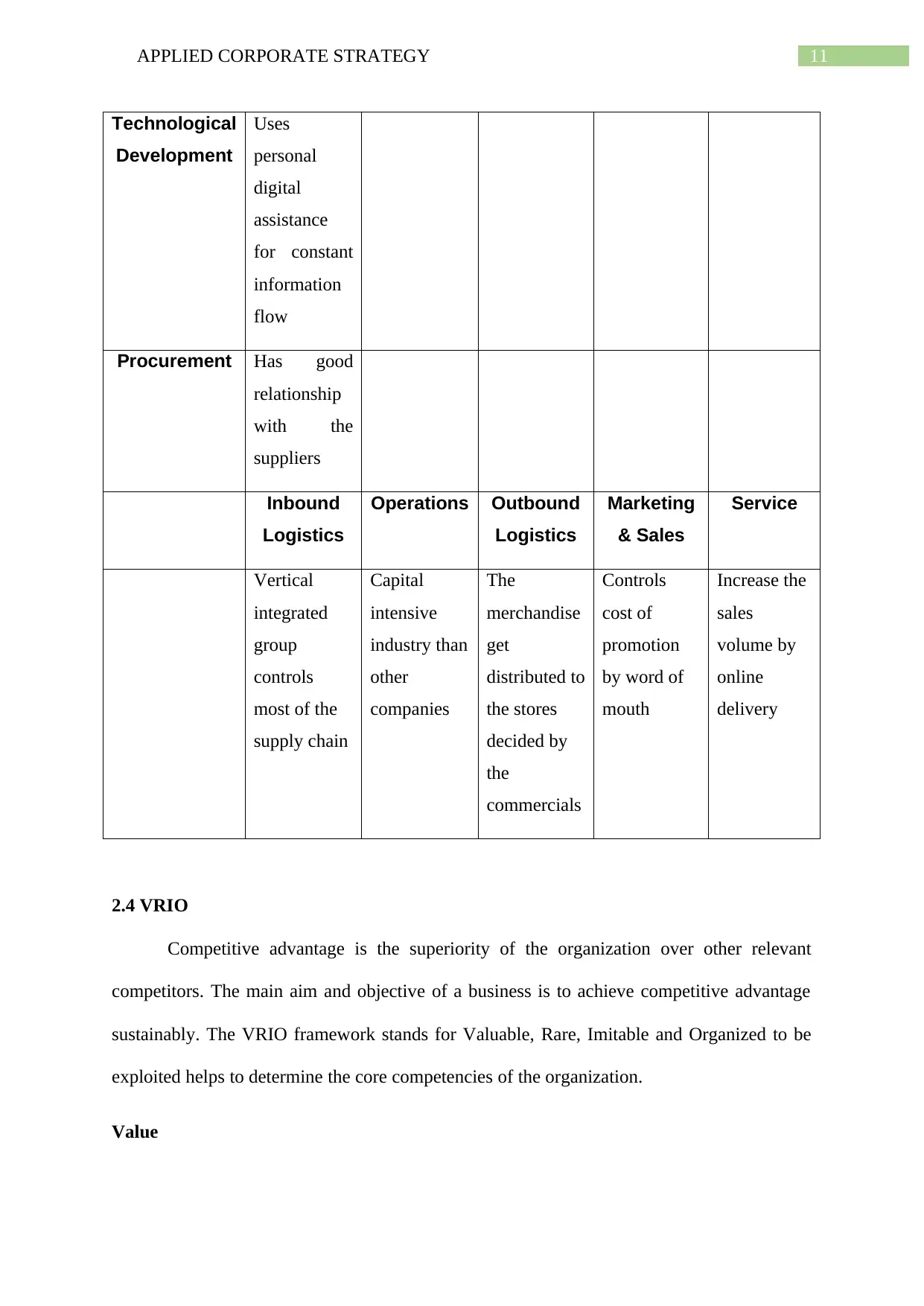
11APPLIED CORPORATE STRATEGY
Technological
Development
Uses
personal
digital
assistance
for constant
information
flow
Procurement Has good
relationship
with the
suppliers
Inbound
Logistics
Operations Outbound
Logistics
Marketing
& Sales
Service
Vertical
integrated
group
controls
most of the
supply chain
Capital
intensive
industry than
other
companies
The
merchandise
get
distributed to
the stores
decided by
the
commercials
Controls
cost of
promotion
by word of
mouth
Increase the
sales
volume by
online
delivery
2.4 VRIO
Competitive advantage is the superiority of the organization over other relevant
competitors. The main aim and objective of a business is to achieve competitive advantage
sustainably. The VRIO framework stands for Valuable, Rare, Imitable and Organized to be
exploited helps to determine the core competencies of the organization.
Value
Technological
Development
Uses
personal
digital
assistance
for constant
information
flow
Procurement Has good
relationship
with the
suppliers
Inbound
Logistics
Operations Outbound
Logistics
Marketing
& Sales
Service
Vertical
integrated
group
controls
most of the
supply chain
Capital
intensive
industry than
other
companies
The
merchandise
get
distributed to
the stores
decided by
the
commercials
Controls
cost of
promotion
by word of
mouth
Increase the
sales
volume by
online
delivery
2.4 VRIO
Competitive advantage is the superiority of the organization over other relevant
competitors. The main aim and objective of a business is to achieve competitive advantage
sustainably. The VRIO framework stands for Valuable, Rare, Imitable and Organized to be
exploited helps to determine the core competencies of the organization.
Value
⊘ This is a preview!⊘
Do you want full access?
Subscribe today to unlock all pages.

Trusted by 1+ million students worldwide
1 out of 24
Related Documents
Your All-in-One AI-Powered Toolkit for Academic Success.
+13062052269
info@desklib.com
Available 24*7 on WhatsApp / Email
![[object Object]](/_next/static/media/star-bottom.7253800d.svg)
Unlock your academic potential
Copyright © 2020–2025 A2Z Services. All Rights Reserved. Developed and managed by ZUCOL.




